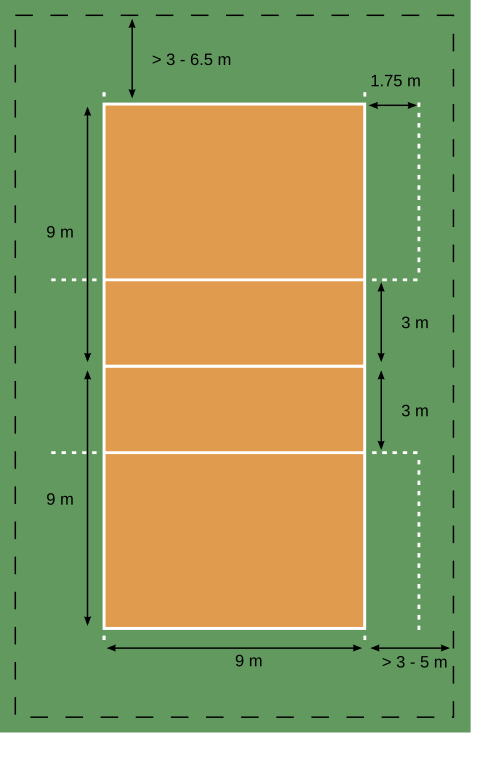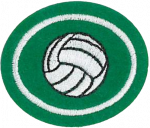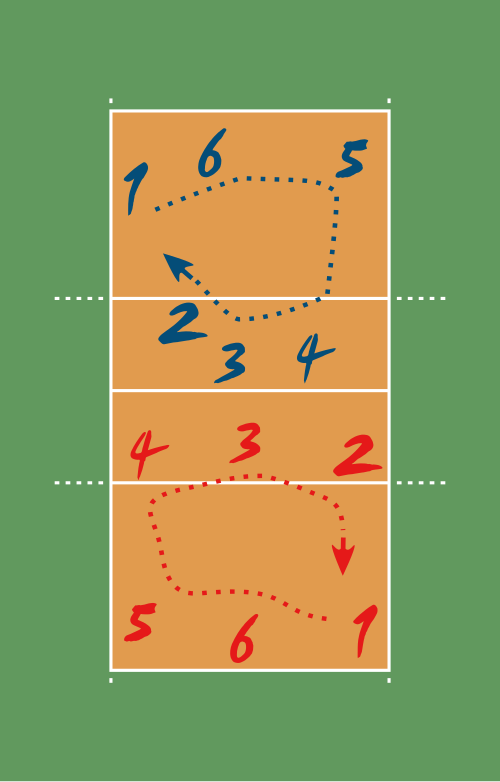AY Honors/Volleyball/Answer Key/es
| Voleibol | ||
|---|---|---|
| Asociación General
|
Destreza: 1 Año de introducción: 2012 |
|
Requisitos
|
La especialidad de Voleibol es un componente de la Maestría Deportista. |
Instructor requerido
Algunas especialidades se designan para requerir un instructor cuando las habilidades no son fáciles de dominar a través del autoaprendizaje. En el voleibol, simplemente no se puede aprender a jugar sin dos equipos.
1
2
3
3a
3b
3c
The attack, also known as the spike, is usually the third contact a team makes with the ball. The object of attacking is to handle the ball so that it lands on the opponent's court and cannot be defended. A player makes a series of steps (the "approach"), jumps, and swings at the ball.
3d
3e
3f
3g
3h
3i
3j
3k
3l
3m
3n
3o
3p
3q
3r
3s
3t
3u
3v
3w
3x
4
5
5a
5b
5c
5d
5e
At the same time, the block position influences the positions where other defenders place themselves while opponent hitters are spiking.
5f
The set is usually the second contact that a team makes with the ball. The main goal of setting is to put the ball in the air in such a way that it can be driven by an attack into the opponent's court. The setter coordinates the offensive movements of a team, and is the player who ultimately decides which player will actually attack the ball.
As with passing, one may distinguish between an overhand and a bump set. Since the former allows for more control over the speed and direction of the ball, the bump is used only when the ball is so low it cannot be properly handled with fingertips, or in beach volleyball where rules regulating overhand setting are more stringent. In the case of a set, one also speaks of a front or back set, meaning whether the ball is passed in the direction the setter is facing or behind the setter. There is also a jump set that is used when the ball is too close to the net. In this case the setter usually jumps off his or her right foot straight up to avoid going into the net. The setter usually stands about ⅔ of the way from the left to the right of the net and faces the left (the larger portion of net that he or she can see).
Sometimes a setter refrains from raising the ball for a teammate to perform an attack and tries to play it directly onto the opponent's court. This movement is called a "dump". This can only be performed when the setter is in the front row, otherwise it constitutes an illegal back court attack. The most common dumps are to 'throw' the ball behind the setter or in front of the setter to zones 2 and 4. More experienced setters toss the ball into the deep corners or spike the ball on the second hit.
As with a set or an overhand pass, the setter/passer must be careful to touch the ball with both hands at the same time. If one hand is noticeably late to touch the ball this could result in a less effective set, as well as the referee calling a 'double hit' and giving the point to the opposing team.
5g
6
This is a great opportunity to learn how to coach and how to be coached. Pair off the players for the coaching part of the honor. Most of the coaching can occur while you are playing games, just intersperse the less experienced players with the more experienced ones, so that the pairs rotate together through the court.
7
Have fun!
8
The requirement presumes you choose a player that is a positive role model. We can't list all the famous volleyball players, but we can provide some general comments.
- Christians and Pathfinders are encouraged to be fit and keep their body in shape because it is God's temple. All athletes must keep themselves in shape as well.
- A good athlete has learned to play well with others, especially in a team sport like volleyball. As Christians we need to be productive members of God's team.
- A good athlete follows the rules or law of the sport. They don't make up rules or choose to ignore rules they dislike. As Christians we must follow God's rules or laws.
- A good athlete will do charitable work, like a good Christian
- A good athlete will teach others to be a good athlete, like a good Christian teaches others to be a good Christian. There is no point in hoarding knowledge of how to be the best you can be.
- A great athlete strives to do their very best. A Pathfinder and Christian should always try to do their very best.
9

A volleyball court is 18 m (59 ft) long and 9 m (29.5 ft) wide, divided into 9 m × 9 m halves by a one-meter (40-inch) wide net. The top of the net is 2.43 m (8 ft 0 in) above the center of the court for men's competition, and 2.24 m (7 ft 4 in) for women's competition, varied for veterans and junior competitions.
The team courts are surrounded by an area called the free zone which is a minimum of 3 meters wide and which the players may enter and play within after the service of the ball. All lines denoting the boundaries of the team court and the attack zone are drawn or painted within the dimensions of the area and are therefore a part of the court or zone. If a ball comes in contact with the line, the ball is considered to be "in". An antenna is placed on each side of the net perpendicular to the sideline and is a vertical extension of the side boundary of the court. A ball passing over the net must pass completely between the antenna (or their theoretical extensions to the ceiling) without contacting them.
The minimum ceiling height clearance for indoor volleyball courts is 7 m (23 ft), although a clearance of 8 m (26 ft) is recommended.
A line 3 m (9.84 ft) from and parallel to the net is considered the "attack line". This "3 meter" (or "10-foot") line divides the court into "back row" and "front row" areas (also back court and front court). These are in turn divided into 3 areas each: these are numbered as follows, starting from area "1", which is the position of the serving player:
After a team gains the serve (also known as siding out), its members must rotate in a clockwise direction, with the player previously in area "2" moving to area "1" and so on, with the player from area "1" moving to area "6". Each player only rotates one time after the team gains possession of the serve; the next time each player rotates will be after the other team wins possession of the ball and loses the point.
10
11
Ellen G. White wrote: "I do not condemn the simple exercise of playing ball; but this, even in its simplicity, may be overdone. I shrink always from the almost sure result which follows in the wake of these amusements. It leads to an outlay of means that should be expended in bringing the light of truth to souls that are perishing out of Christ" --Selected Messages Book 2, pg. 322.
Here, then, is one of the dangers of athletic sports: the expense involved. Naturally, the more professional the athletic program, the more structured the games, the more intense the competition, the greater will be the temptation to spend money for equipment, travel, rental of facilities, or, in the case of an institution, the construction and maintenance of sports facilities.
In this same passage, Ellen White says that it is "the way" that ball games "have been conducted at the college" at Battle Creek that "does not bear the impress of heaven. . . . There are threads leading out through the habits and customs and worldly practices, and the actors become so engrossed and infatuated that they are pronounced in heaven, lovers of pleasure more than lovers of God." --Ibid.
Here is a second danger in athletic sports. If they are not properly conducted they become en grossing and infatuating.
She also states: "The games that occupy so much of ... [the student's] time are diverting the mind from study. They are not helping to prepare the youth for practical, earnest work in life. Their influence does not tend toward refinement, generosity, or real manliness.
"Some of the most popular amusements, such as football and boxing, have become schools of brutality. They are developing the same characteristics as did the games of ancient Rome. The love of domination, the pride in mere brute force, the reckless disregard of life, are exerting upon the youth a power to demoralize that is appalling.
"Other athletic games, though not so brutalizing, are scarcely less objectionable because of the excess to which they are carried, they stimulate the love of pleasure and excitement, thus fostering a distaste for useful labor, a disposition to shun practical duties and responsibilities. They tend to destroy a relish for life's sober realities and its tranquil enjoyments. Thus the door is opened to dissipation and lawlessness, with their terrible results." --The Education, pg. 210 & 211.
Look again at this quotation and ask yourself this question: Is it not true that every danger brought to view here is all the more hazardous the more intense the competition becomes?
The more competition involved, the more the student's time is consumed and the more he is diverted from preparation for practical life. The more intense the competition, the more brutal the game becomes as any football or basketball fan can tell you. The greater the competitive incentive, the greater the love for victory, the love of domination. Winning is the only thing. The future is now. Losing is like death. The more intense the competition, the more reckless becomes the dis regard of life. When competitive factors dominate an athletic event, that is when the stimulation and pleasure is the greatest, when practical duties are most likely to be neglected, when life's sober realities and tranquil enjoyments lose their relish, and the door is opened most widely to dissipation.
In 1899 Ellen White was in Sydney, Australia, when she encountered a huge crowd on one of the streets. "Hundreds and hundreds, and I might say thousands, were gathered together. 'What is the matter?' I asked. 'It is because of the cricket match,' was the answer. And while men were playing the game of cricket, and others were watching the game, Satan was playing the game of life for their souls.' " In Australasian Union Conference Record, July 26, 1899.
It's not just talking about about baseball or flagball or basketball. We're talking about a far more important game: the game of life. Our opponent is Satan, and only here may it truly be said, "Winning isn't every thing, it's the only thing."
Pathfinders and Christians must be cautious to what standard they hold games and how it is affecting their spiritual life and study of the Word.
12
This is going to be fairly personal, so start thinking about this as you learn volleyball so you can share later.
References
- Categoría: Tiene imagen de insignia
- Adventist Youth Honors Answer Book/Honors/es
- Adventist Youth Honors Answer Book/es
- Adventist Youth Honors Answer Book/Skill Level 1/es
- Categoría: Libro de respuestas de especialidades JA/Especialidades introducidas en 2012
- Adventist Youth Honors Answer Book/General Conference/es
- Adventist Youth Honors Answer Book/Recreation/es
- Adventist Youth Honors Answer Book/Recreation/Primary/es
- Adventist Youth Honors Answer Book/Stage 0/es
- Adventist Youth Honors Answer Book/Sportsman Master Award/es
- Adventist Youth Honors Answer Book
- Instructor Required


